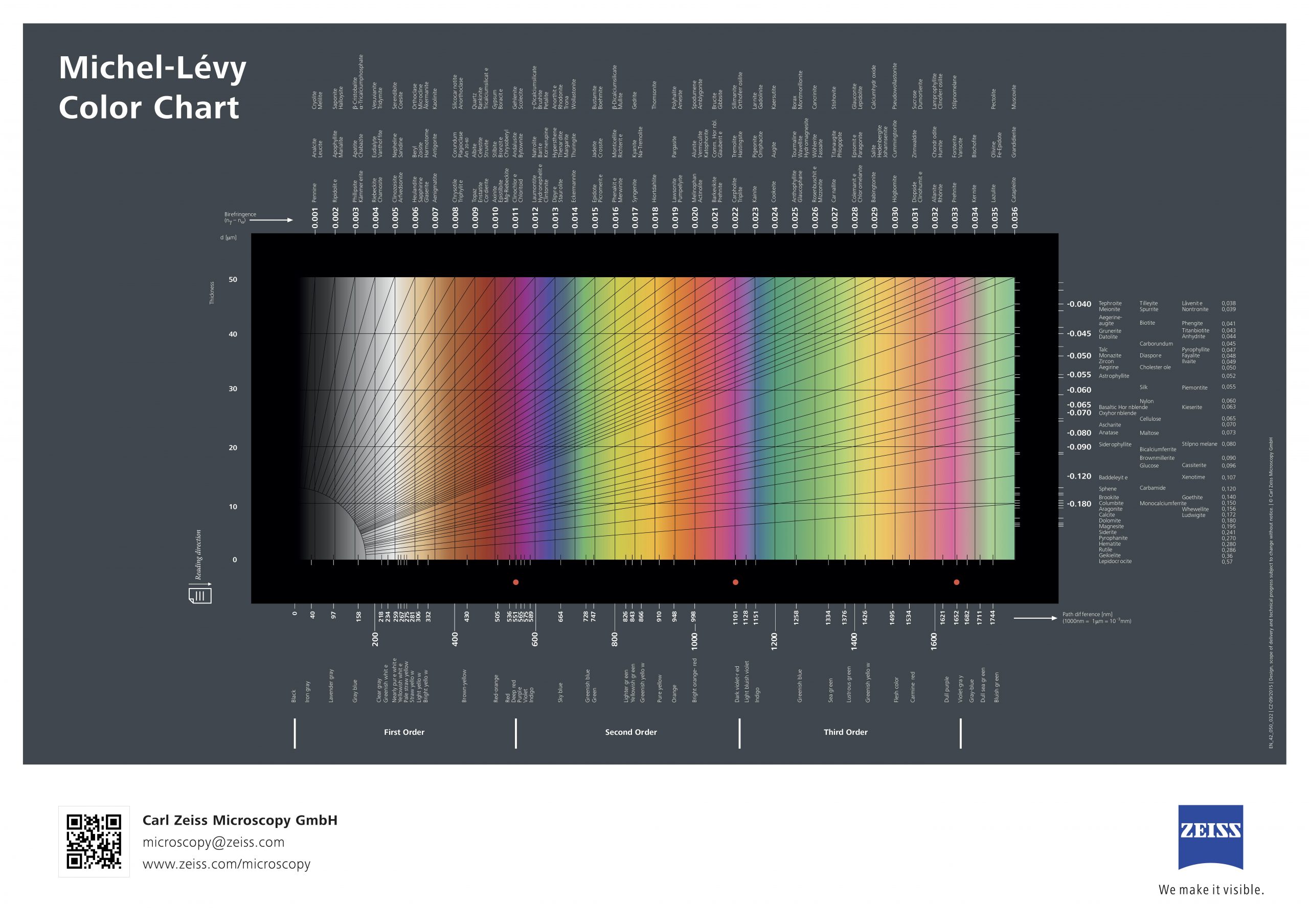Example Chapters
2.7 Properties Under Cross Polarized Light
Elizabeth A. Johnson; Juhong Christie Liu; and Mark Peale
This chapter is originally from “Introduction to Petrology” by Elizabeth A. Johnson and Juhong Christie Liu, available under a Creative Commons Attribution Noncommercial-ShareAlike 4.0 International License.
In this section, we explore properties that can be observed for minerals under cross polarized light, when both the lower polarizer and the analyzer (top polarizer) are inserted into the polarizing light microscope.
In this section, students will learn to:
- Distinguish between anisotropic and isotropic minerals.
- Determine the interference colors, birefringence, and retardation for a mineral grain.
- Evaluate if a mineral has parallel or inclined extinction to help identify the mineral.
- Observe and record other mineral properties in cross polarized light such as twinning, zoning, and textural features.
OVERVIEW OF PROPERTIES IN Cross POLARIZED LIGHT
This video gives an overview of some of the important properties of minerals in cross polarized light. These properties, plus a few others, are explored in more detail in the sections below.
Figure 2.7.1. Explanations of isotropic versus anisotropic minerals, interference colors, birefringence, and retardation. Earth Optics Videos, CC-BY.
Isotropic vs. Anisotropic Minerals
Isotropic minerals have crystal structures which have the same structure in every direction. They belong to the isometric crystal system. All other minerals are anisotropic, meaning their crystal structures vary with direction. These are minerals belong to the hexagonal, tetragonal, orthorhombic, monoclinic, and triclinic crystal systems. (See Section 2.8 Interference Figures and Crystal Symmetry for a chart of the crystal systems). The table below summarizes characteristics of opaque, isotropic, and anisotropic minerals.
| Mineral type | Characteristics in Plane Polarized Light | Characteristics in Cross Polarized Light |
| Opaque | Mineral appears dark | Mineral appears dark even when rotated |
| Isotropic | Light passes through mineral | Mineral appears dark even when rotated |
| Anisotropic | Light passes through mineral | Mineral exhibits interference colors and goes dark (extinct) every 90 degrees |
Inclined and Parallel Extinction
If a mineral has cleavage, determining if it has parallel or inclined extinction can be useful to distinguish it from similar minerals. Under cross polarized light, a mineral with parallel extinction will go extinct (dark) when the cleavage direction is parallel to the north-south and east-west directions as the stage is rotated. A mineral with inclined extinction will go extinct with the cleavage at an angle to these directions as the stage is rotated. The cross hairs on the ocular should be used as a guide for this measurement.

Figure 2.7.4. An example of determining inclined or parallel extinction. 40x total magnification.
Interference Colors, Birefringence and Retardation
The color of a mineral under cross-polarized light is called its interference color. Interference colors categorized by first, second, third, and fourth-order colors are shown in Figure 2.7.5.

Figure 2.7.5 is the Michel-Levy Interference Color Chart. To better view the text and labels on the full-sized image, click on this link to the original file on Wikipedia. This diagram displays the interference colors in the chart, with verbal descriptions of first-, second-, and third-order colors below the x-axis. The y-axis on the left side of the diagram is thickness of the mineral (or thin section) in micrometers.
The physical property called birefringence (δn, or nγ – nα) is plotted along diagonal lines across the diagram. The value of birefringence for each diagonal line is listed at the top and right sides of the diagram. Minerals are listed across the top and right side of the diagram next to their birefringence value.
The slice of rock on a standard thick section is about 30 micrometers thick. To determine birefringence, use these steps:
- Determine the (maximum) interference color of the mineral. It may be necessary to look at several grains of the same mineral, since many times they will be oriented differently within the thin section. If you are unsure of the interference color, it can be helpful to look at the edges of the mineral grain, which may show interference color banding that can help narrow down the color.
- Locate the interference color on the Michel-Levy chart, and find where it intersects the horizontal line for 30 micrometers.
- From this point, follow the diagonal line to the top of the chart to determine the birefringence value, and to see minerals with this birefringence.
Other Textures Under Crossed Polarized Light
There are many other textures and features that may be revealed under cross polarized light which are not visible or not obvious under plane polarized light. These can include twinning (Figure 2.7.7), zoning due to compositional changes during crystal growth (Figure 2.7.8), undulatory extinction (Figure 2.7.9) or other deformation textures, and exsolution lamellae (Figure 2.7.10) in which one mineral separates into two minerals, producing a striped effect.
Figure 2.7.8. Oscillatory zoning in plagioclase crystals, 100x total magnification. Mt. Jefferson dacite, Oregon.
Figure 2.7.9. Quartz exhibiting undulatory extinction under cross polarized light 100x total magnification. Cranberry Gneiss, near Galax, VA.
References
Earth Optics Videos (Nov 27, 2015). Earth Optics Video 2: Cross Polarized Light. CC-BY license. https://www.youtube.com/watch?v=OB7UbgiDGW0

